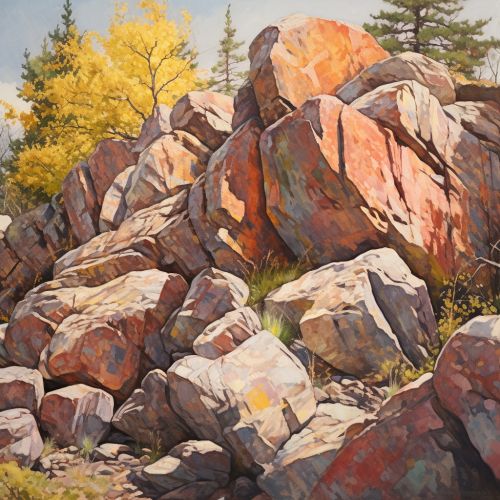Granite
Introduction
Granite is a common type of igneous rock that is granular and phaneritic in texture. Granites can be predominantly white, pink, or gray in color, depending on their mineralogy. The word "granite" comes from the Latin granum, a grain, in reference to the coarse-grained structure of such a holocrystalline rock.


Formation and Composition
Granite is formed from the slow crystallization of magma beneath the Earth's surface. It is composed mainly of quartz and feldspar with minor amounts of mica, amphiboles, and other minerals. This mineral composition usually gives granite a red, pink, gray, or white color with dark mineral grains visible throughout the rock.
Types of Granite
There are many different types of granite, which are classified based on their mineralogical composition. These include:
- Biotite Granite: A type of granite that contains substantial amounts of biotite mica.
- Hornblende Granite: This type of granite contains a high percentage of the mineral hornblende.
- Tourmaline Granite: A granite variant that contains tourmaline, a crystalline boron silicate mineral.
- Muscovite Granite: This type of granite contains substantial amounts of muscovite mica.
Uses of Granite
Granite has been used for thousands of years in both interior and exterior applications. Rough-cut and polished granite is used in buildings, bridges, paving, monuments, and many other exterior projects. Indoors, polished granite slabs and tiles are used in countertops, tile floors, stair treads, and many other design elements. Granite is also used as a crushed stone or aggregate. In this form, it is used as a base material at construction sites, as an aggregate in road construction, railroad ballast, foundations, and anywhere that a crushed stone is useful as fill.
Granite Mining and Processing
Granite is mined from the earth, with several techniques being used. The most common of these are open-pit mining, using saws and drills to cut the granite out of the quarry. Once the granite is cut and removed, it is then processed. This involves polishing the granite and cutting it into slabs or tiles, ready for use in construction.
Environmental Impact of Granite Mining
The environmental impact of granite mining can be significant. The process of mining can result in soil erosion and loss of biodiversity. Additionally, the use of explosives in the mining process can result in noise and dust pollution. However, modern practices have improved to reduce the environmental impact, including the use of water during cutting to reduce dust, and the reclamation of mined land.
